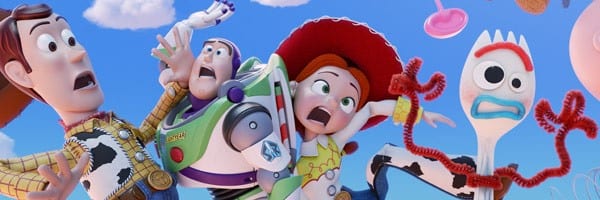Toy Story 4: Forky Explained and the Rules of Being a Toy in Pixar’s World – Collider.com
 Toy Story 4 has done something that no previous Toy Story movie has done. Not only did Andrew Stanton and Stephany Folsom‘s script introduce the decidedly nontraditional toy character known as Forky (Tony Hale), it also chose to explore the mythology behind what it means to be a toy in Pixar’s fictional franchise. How are they made? What gives them sentience? What separates trash from toys? And what rules does a toy have to follow simply by the nature of being a toy?
Toy Story 4 has done something that no previous Toy Story movie has done. Not only did Andrew Stanton and Stephany Folsom‘s script introduce the decidedly nontraditional toy character known as Forky (Tony Hale), it also chose to explore the mythology behind what it means to be a toy in Pixar’s fictional franchise. How are they made? What gives them sentience? What separates trash from toys? And what rules does a toy have to follow simply by the nature of being a toy?
These are all heady, existential questions, and you don’t need to ponder the answers to them to enjoy Toy Story 4. It’s arguably the funniest of the four films and features some madcap sequences populated with the silliest characters in the franchise who are brought to life by some of the most talented actors working today. It’s got heart, humor, and an added tinge of nostalgia, while also acting as a possible (hopeful) swan song for the toys we’ve spent nearly 25 years getting to know. Be sure to read Matt Goldberg‘s review here. But there’s an interesting subtext here about what it means to be a toy that I’d like to explore. Some spoilers follow.
 Back in 1995, Pixar’s Toy Story burst onto the scene in a big way as the studio’s first feature film and the first-ever movie to be completely computer-animated. The conceit was straightforward: A group of toys fear being forgotten and abandoned by their owner, Andy, when his birthday party brings the threat of brand new toys into their closed world. While Toy Story may have reawakened that childhood guilt from not giving an equal share of playtime to each and every one of your toys, it also introduced a fantastic franchise that would go on to tell earnest stories exploring the human emotional condition for the next 25 years (at least). But another aspect of Toy Story that’s been less explored by the movies over the years has been the mythology around the actual toys themselves.
Back in 1995, Pixar’s Toy Story burst onto the scene in a big way as the studio’s first feature film and the first-ever movie to be completely computer-animated. The conceit was straightforward: A group of toys fear being forgotten and abandoned by their owner, Andy, when his birthday party brings the threat of brand new toys into their closed world. While Toy Story may have reawakened that childhood guilt from not giving an equal share of playtime to each and every one of your toys, it also introduced a fantastic franchise that would go on to tell earnest stories exploring the human emotional condition for the next 25 years (at least). But another aspect of Toy Story that’s been less explored by the movies over the years has been the mythology around the actual toys themselves.
Toy Story establishes the basics: First and foremost, toys in this world are anthropomorphic and lead lives of their own whenever humans are not around but must never be seen as anything other than playthings by humans. They also come with personalities and outlooks befitting their creation (ie an adventurous Space Ranger and a law-keeping cowboy sheriff), might not instantly recognize that they are in fact toys, and desperately desire children to want to play with them and love them. That latter idea was core to the Toy Story story, an evolution of the central idea in the 1988 Pixar short Tin Toy, which saw toys terrified of their destructive owners. But Toy Story also introduced an interesting wrinkle to the mythology of toy creation through the Dr. Frankenstein-like neighbor kid, Sid Phillips.
Sid is put forward as an obstacle to overcome, a sort of miniboss, in the first movie, but he’s also the first character to create a toy that didn’t come out of a box. Sure, Sid’s mutant toys are cobbled-together pieces of other toys, like action figures, baby dolls, and Erector Sets, so they’re less creations from whole cloth and more abominations of existing toys. These mutant toys still abide by the rules of toys established elsewhere in the film; it’s just their appearance that’s been drastically altered. But these good-hearted toys can be pushed too far. With Buzz’s life on the life, Woody rallies the mutants to break the #1 rule of Toyhood in order to scare Sid straight:
[embedded content]
As of the release of Toy Story 4, Sid remains the only human who’s aware of toys’ sentient nature. Somehow, he managed to grow up into a well-adjusted individual despite this horrifying Small Soldiers / Puppetmaster scenario and was last seen employed as a garbage man.
Let’s block ads! (Why?)

